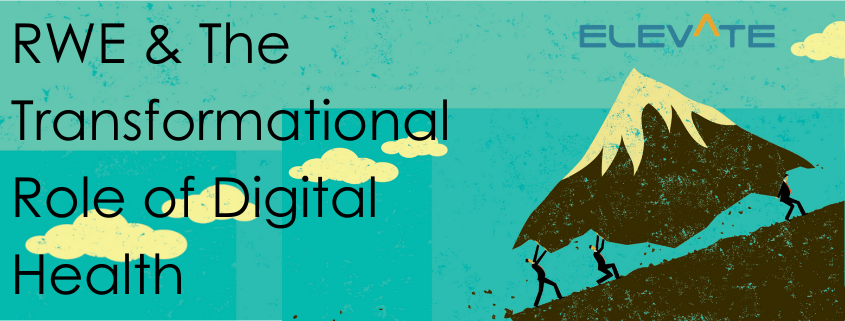RWE & The Transformational Role of Digital Health
The digital health revolution implies a clear understanding of strategy, using technology as an enabler to create better outcomes for patients and to power value creation across the healthcare ecosystem. As data specialists, Medical Affairs professionals will be at the forefront of this transformation.
 The medical world is changing and changing fast. As multiple new technologies start to transform every aspect of the healthcare ecosystem and the lines between biosciences and data science fade, companies need medical leaders who not only understand the latest medical advances but also the potential and scope of data and digital, along with their implications – not least that this new paradigm requires strategists who are comfortable with organizational transformation and who can lead change. Dr Rajni Aneja is one such strategist: she specializes in the crossover between business and technology across a variety of health sectors.
The medical world is changing and changing fast. As multiple new technologies start to transform every aspect of the healthcare ecosystem and the lines between biosciences and data science fade, companies need medical leaders who not only understand the latest medical advances but also the potential and scope of data and digital, along with their implications – not least that this new paradigm requires strategists who are comfortable with organizational transformation and who can lead change. Dr Rajni Aneja is one such strategist: she specializes in the crossover between business and technology across a variety of health sectors.
“My training falls at the intersection of business and technology and I have worked across all different healthcare sectors from payer to a consumer digital company to pharma, as well as being involved in an advisory capacity for innovation and strategy in health for MIT and Harvard Innovation Lab, along with Oliver Wyman, and many other start-up companies.
“From an industry standpoint, I am interested in the role of digital facilitating consumer as well as HCP engagement strategies, or patient journeys through a variety of touch points leading to better clinical outcomes, better clinical interactions, better patient experiences, better healthcare provider experiences, as well as better delivery of healthcare.”
Technology as an enabler
This approach is all about strategically using digital as an enabler driven by data. “When we create a strategy around a digital experience, it’s not about the technology. I see the technology as an enabler: when you apply the right technology at the right point and have the right interventions designed – either for the provider or patients – that is when it actually is impactful or meaningful.”
Longer term, advances in bioscience and digital technology have the potential to add value to the system in multiple ways: for example, by transforming the R&D process to potentially make it shorter, more specific, and take out cost; by ensuring better health outcomes for patients, bringing forward new treatments more quickly, and generally improving the patient experience; and by providing opportunities for physicians through new options to advance patient care and offering new ways to engage and learn.
Start of the journey
We are only at the start of this journey today but Dr Aneja points to significant potential that already exists. “As a physician, when you see patients in clinics, you’re only seeing 15 to 20 patients in a day. But if you have technologies like telemedicine, where you are delivering consultations on videos, or you’re delivering care to remote areas, your impact and outreach becomes much wider and much more significant.
“I see telemedicine as one of the technologies to have gained a lot of momentum, not only for its potential in clinical trials but also for prevention and wellness visits, or even acute care visits. But what’s coming next? I think the future is where data is driving or enabling these technologies, and this is where artificial intelligence or machine learning comes into play. However, if the data is not good enough, anything that is going to come out of it is not going to be good enough: garbage in, garbage out. The importance of data as an asset is that you drive intelligent decision-making and that is only done through insights generated by the power of data that is collected from a variety of technology enablers.” As an example, she cites finding the right patient for the right clinical trial at the right time for the right medical condition, while delivering the right care, all of which can be powered and informed by the data.
Data requirement implies collaboration
Today, real-world evidence (RWE) and data – especially continuous real-time data – sits at the heart of where the healthcare ecosystem is headed, not least in the context of value-based health design and care delivery, where (especially in the US) the system is moving from volume to value, and there is more emphasis on better outcomes. This implies that data can be both shared and combined effectively, and also that RWE – including data directly from the consumer, say from wearables – can be integrated with historical data and combined with real-time analytics.
“There’s an evolving trend that we’re seeing: in the last two to three years pharmaceutical companies have started to work very closely with the payers. But the industry is becoming disrupted and I think all these stakeholders can learn from each other to say: ‘How am I going to be a leader in the game instead of a follower?’”
The trend within the healthcare sector is asking for more integration of data and collaboration between organizations – joining the dots – to generate insight from the payers as well as from pharma and from consumers. “This is a collaborative effort around value-based care and an outcome-based approach, which will lead to better patient care and better clinical trials. But there are many challenges remaining before this data utopia becomes reality, including a lack of agreement on definitions of what constitutes value. What is considered good-quality data, data privacy, data governance and data security and many others factors would play a vital role in shaping the thought process as we move along this transformation journey.”
HURDLES…

So, what are the hurdles? The regulatory environment is one, but regulators and government are increasingly aware of the need to advance. We have seen the introduction of the 21st Century Cures Act; as well as statement from FDA commissioner, Scott Gottlieb about the importance of digital health and real-world evidence, and there are efforts now around guidance from the governing bodies. Commercial sensitivity is another issue, but industry is increasingly acknowledging the need for collaboration – perhaps through neutral consortium – to harness the power of data and analytics. As an example, Dr Aneja cites the NEWDIGS project, through MIT’s Center of Biomedical Innovation, which brought together various pharmaceutical partners in a neutral, non-biased, cohesive setting. However, she acknowledges that “we’re taking baby steps and are in exploration mode with a desire for more collaborative models, and not yet ready for prime time yet.”
…AND BENEFITS
 And what about the benefits? There is clearly substantial value in a system that encourages us to learn about the patient – not least, greater customization, personalization, and simplicity for the patient. This encompasses patient-reported outcomes, behavioral profiles, social, and other demographic data leading to consumer segmentation, which in turn can deliver on targeted interventions and interactions.
And what about the benefits? There is clearly substantial value in a system that encourages us to learn about the patient – not least, greater customization, personalization, and simplicity for the patient. This encompasses patient-reported outcomes, behavioral profiles, social, and other demographic data leading to consumer segmentation, which in turn can deliver on targeted interventions and interactions.
Dr Aneja elaborates: “I’ll give you an example. Rajni is a 40-year-old female who runs every day and is pretty healthy and motivated and doesn’t take any medicine, but is very interested in her well-being. Because of the combination of data from different sources, we can create a profile of what Rajni wants, what Rajni needs, how we engage her, how we motivate her and do that on a continuous long-term basis; and data can enable targeted, personalized interventions – interactions that are actually applicable to Rajni, not one-size-fits-all. Data can help you get to that level of granularity, but I always say that with a word of caution: we’re not there yet. But that doesn’t mean that we can’t get there; it’s just that we’re on our way to this kind of transformation.”
And this opens up a whole world of further possibilities: Rajni might be part of a cohort that you could segment in the context of preventative health and screening, and so on. So there’s an opportunity to gain a depth of insight into individual patients within a population. “Imagine if you could understand, in your population, who are my well people? Who are my sick people? Who are the people who are very, very motivated? Who are people that actually need a lot of nudging because they’re not motivated? With the years of data, you have the ability to be not only predictive but at some point can be prescriptive, especially for precision medicine.”
Beyond this, digital needs to make life simpler and more convenient for patients. Healthcare is already becoming more consumer-centric. “I think it’s already happening. You already have Uber Health; we have telemedicine solutions; we have remote monitoring; we have wearables and sensors. I think the trend that we see is consumers becoming more involved in taking responsibility for health; they’re becoming more informed. Consumers want to manage their health, want to see their healthcare data, and want to be equally responsible for decision-making.
THE FUTURE

What needs to happen going forward? “I think it’s an industry shift.” There is recognition that we need to accelerate this process, according to Dr Aneja. In conclusion, she sees a significant role for Medical Affairs within this new environment – as the conduit of the digital transformation. MA can help define the problems we are trying to solve, along with the data sets and technology that will enable a solution. “They are absolutely vital. You would not create an initiative in a silo; technology is an enabler. Ultimately the insights coming from MA about what problems we need to create an effective solution for will lead to better patient outcomes as well as better patient experience.”
“It actually allows you to apply the right interventions to the right patient at the right time, which is critical.”
Biography
Rajni Aneja is an MIT Connection Science Fellow, healthcare strategist, public speaker, and transformative change agent with expertise in population health management and digital health. She serves as an adviser to a variety of health and wellness organizations. Dr Aneja encompasses various vantage points as a clinician, executive, adviser, entrepreneur, speaker and technology advocate serving in senior leadership roles. These include Chief Medical Officer for WebMD health, EVP of Joslin and a strategic executive and transformation leader at Humana. Most recently she contributed to the building of a digital consumer strategy at Novartis. Dr Aneja received her MD from Research Medical Center in Kansas City and her MBA from the University of Massachusetts.




